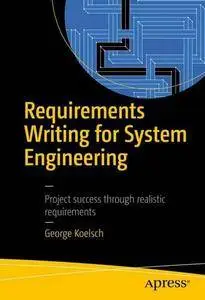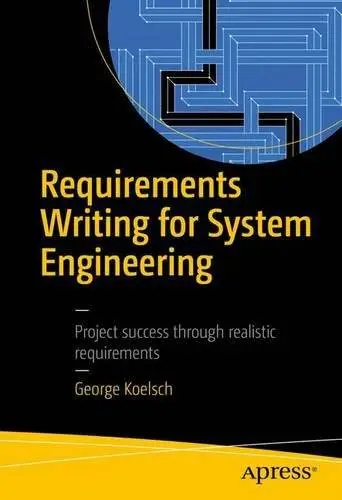Requirements Writing for System Engineering
Apress | Software Development | Nov. 16 2016 | ISBN-10: 1484220986 | 400 pages | pdf | 9.84 mb
Apress | Software Development | Nov. 16 2016 | ISBN-10: 1484220986 | 400 pages | pdf | 9.84 mb
Authors: Koelsch, George
Presents 13 techniques for capturing requirements
Demonstrates gap analysis to find missing requirements
Shows how to address both software and hardware needs
Provides extensive examples of 'shall' statements, user stories, and use cases
Learn how to create good requirements when designing hardware and software systems. While this book emphasizes writing traditional “shall” statements, it also provides guidance on use case design and creating user stories in support of agile methodologies. The book surveys modeling techniques and various tools that support requirements collection and analysis. You’ll learn to manage requirements, including discussions of document types and digital approaches using spreadsheets, generic databases, and dedicated requirements tools. Good, clear examples are presented, many related to real-world work the author has done during his career.
Requirements Writing for System Engineeringantages of different requirements approaches and implement them correctly as your needs evolve. Unlike most requirements books, Requirements Writing for System Engineering teaches writing both hardware and software requirements because many projects include both areas. To exemplify this approach, two example projects are developed throughout the book, one focusing on hardware and the other on software.
This book
Presents many techniques for capturing requirements.
Demonstrates gap analysis to find missing requirements.
Shows how to address both software and hardware, as most projects involve both.
Provides extensive examples of “shall” statements, user stories, and use cases.
Explains how to supplement or replace traditional requirement statements with user stories and use cases that work well in agile development environments
What You Will Learn
Understand the 14 techniques for capturing all requirements.
Address software and hardware needs; because most projects involve both.
Ensure all statements meet the 16 attributes of a good requirement.
Differentiate the 19 different functional types of requirement, and the 31 non-functional types.
Write requirements properly based on extensive examples of good ‘shall’ statements, user stories, and use cases.
Employ modeling techniques to mitigate the imprecision of words.
Audience
Writing Requirements teaches you to write requirements the correct way. It is targeted at the requirements engineer who wants to improve and master his craft. This is also an excellent book from which to teach requirements engineering at the university level. Government organizations at all levels, from Federal to local levels, can use this book to ensure they begin all development projects correctly. As well, contractor companies supporting government development are also excellent audiences for this book.
Number of Pages
XXIII, 400
Number of Illustrations and Tables
3 b/w illustrations, 15 illustrations in colour
Topics
Software Engineering
Project Management
Software Management
Computer System Implementation
Management of Computing and Information Systems
Click Here for More books



